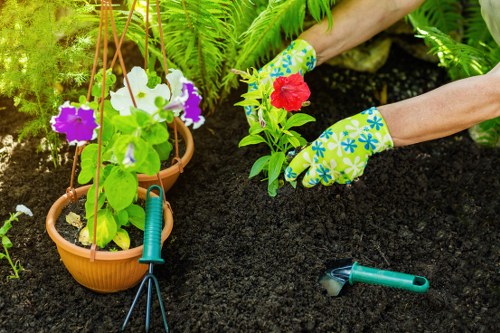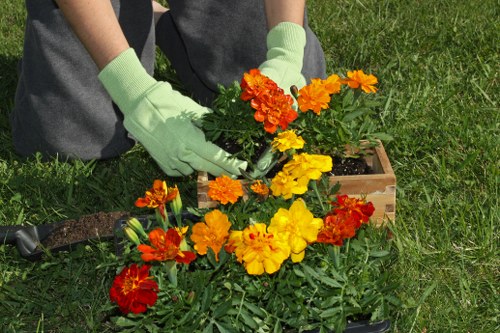Exploring Garden Maintenance Temple: Nurturing Sacred Gardens and Community Spirit

Welcome to our comprehensive look at the Garden Maintenance Temple—a unique concept that blends the art of maintaining lush, vibrant gardens with the rich cultural heritage of temples. In this article, we explore the importance of garden maintenance as it relates to sacred temple spaces. We aim to show how careful upkeep not only enhances natural beauty but also fosters a sense of community and respect for tradition.
Every garden, especially those around temples, is steeped in history and spirituality. The simple act of tending to flowers, shrubs, and trees becomes a deliberate ritual. It is a way to honor nature and preserve the tranquil environment that these sacred spaces offer. Garden Maintenance Temple initiatives are springing up to ensure that these gardens remain lush, vibrant, and welcoming.
When you visit a Garden Maintenance Temple, you witness more than just a mix of flora; you experience a sense of calm that comes with careful, mindful care. This article explores the best practices in garden upkeep, the significance of maintaining beauty in temple gardens, and how a community can rally to support these efforts. Our discussion is aimed at inspiring both gardening enthusiasts and temple visitors alike.

Understanding the principle of garden maintenance is key to appreciating temple gardens. Much like a living organism, these gardens need regular nurturing. Watering, pruning, and weeding are just a few of the daily tasks that help keep these plants healthy. The process is not just practical but also symbolic.
Gardens at temples have great symbolism. They represent rebirth, growth, and renewal. Every trimmed hedge or blossoming flower is a testament to the temple's ongoing mission of spiritual regeneration. Garden maintenance is also an opportunity to engage in acts of meditation and reflection, making each task more meaningful.
The Garden Maintenance Temple concept empowers communities to work together with care and devotion. It invites community volunteers, local artisans, and gardening experts to share their knowledge and passion. The ongoing maintenance of these spaces acts as a unifier, bringing people from different walks of life together.

In this discussion, we seamlessly blend practical advice with cultural insights. We outline a variety of techniques in garden maintenance which include seasonal planting, organic pest control, and sustainable water practices. These methods are essential for keeping temple gardens both beautiful and eco-friendly.
A sustainable approach to garden care means balancing aesthetics with environmental responsibility. Gardening techniques that reduce water waste, lower chemical use, and encourage native species are prioritized. This ensures the longevity of these historical sanctuaries.
Our goal is to foster a better understanding of the intertwined relationship between spirituality, nature, and community. Through careful planning and continuous efforts, every temple garden can flourish, inviting visitors to reflect on life and nature.
Core Principles of Garden Maintenance Temple

The principles that guide the Garden Maintenance Temple concept are both timeless and practical. Respect, sustainability, and community stewardship form the basis of every maintenance project. Whether you are an experienced gardener or a beginner, these guiding principles lead you in the right direction.
Respect for nature is the heart of garden maintenance. This means acknowledging the sacred nature of the temple and the living organisms that flourish within its confines. When every task is performed with mindfulness, the outcome is a space that radiates positive energy and calm.
Another core attribute is sustainability. Simple, eco-friendly practices have long-lasting impacts. This includes the use of organic fertilizers, water-saving irrigation systems, and careful pest control strategies. These methods protect the local ecology while also preserving the aesthetic appeal of temple gardens.

Community stewardship is a central element as well. When local communities come together to maintain temple gardens, a network of care is built that benefits everyone. Volunteers, local organizations, and temple caretakers all contribute their time, energy, and expertise to this noble cause.
The collective effort in garden upkeep reflects the society's respect for tradition and nature. Involvement in such activities nurtures a shared responsibility for preserving spaces that are not only culturally significant but also environmentally friendly.
This integrated approach, where sacred space meets green practices, has transformed many temple gardens into living works of art. The result is a serene environment that welcomes both locals and visitors, offering an escape from the fast pace of modern life.
Essential Techniques in Garden Maintenance Temple
To ensure that garden maintenance is both effective and sustainable, several specialized techniques are employed. These methods are designed to be simple yet efficient, making them accessible at an 8th-grade reading level for anyone interested in helping out.
Watering and Irrigation Practices
Watering is the cornerstone of any garden maintenance plan. Effective irrigation systems guarantee that every plant receives the precise amount of water required to thrive. Traditional methods have evolved to incorporate modern, water-saving technologies.
Here are some basic watering practices:
- Drip Irrigation: This system minimizes waste by delivering water directly to the roots of plants.
- Soaker Hoses: These help maintain consistent moisture in the soil, especially during hot periods.
- Rainwater Harvesting: Embracing natural resources reduces the reliance on municipal water systems.

The use of drip irrigation and soaker hoses not only conserve water but also prevent overwatering, which can lead to plant diseases. Applying these techniques within a Garden Maintenance Temple setting is both practical and symbolic, reflecting the careful attention given to every living element.
Water conservation plays a vital role in reducing environmental impact and ensures that sacred spaces maintain their natural charm. Using rainwater for irrigation further embeds the practice in sustainability and respect for nature.
These practices, while simple, form the backbone of a well-maintained temple garden, ensuring that both essential flora and cherished traditions continue to thrive.
Pruning and Weeding
Regular pruning and weeding are necessary to keep a garden looking its best. Pruning helps shape the plants, remove dead branches, and encourage new growth. It is a task that should be done with care and precision.
Similarly, hand weeding removes unwanted plants that may compete with the sacred flora. Even though it might seem labor-intensive, manual weeding is key to preserving the overall health of the garden.
Gardeners often use specialized tools that help them tidy up the space efficiently and safely. Whether you use shears or manual tools, the focus remains on creating a harmonious environment that honors both nature and tradition.

The careful combination of pruning and weeding not only improves the garden's look but also boosts the resilience of the plant life. When removing decayed or excess growth, gardeners ensure that the remaining plants receive ample resources and space to flourish.
This meticulous attention to detail is part of what makes Garden Maintenance Temple practices so revered. It's a process that mirrors the temple's broader commitment to order, balance, and natural beauty.
Through routine maintenance, both new visitors and long-time community members can appreciate the evolving beauty of the temple gardens with each season.
Soil Health and Organic Fertilizers
Just like any other garden, the health of the soil is critical in a Garden Maintenance Temple. Organic fertilizers and natural compost are preferred to nourish the soil and enhance plant growth. The practice of enriching the soil is intertwined with respect for the environment.
Maintaining soil health involves regular testing and the addition of natural amendments. These methods eliminate the need for harsh chemicals and sustain both plant and human well-being.
Organic practices in soil maintenance are at the heart of temple traditions. They remind us that nurturing our environment is a sacred duty, echoing ancient rituals that honor the earth.

One effective practice is creating compost from recycled organic matter. This process not only minimizes waste but also returns valuable nutrients to the soil. It is a tradition that aligns closely with the sustainable practices of Garden Maintenance Temple.
When organic fertilizers replace synthetic options, gardens flourish naturally. Strong, healthy plants are a symbol of rejuvenation and respect for nature’s cycles.
The ongoing investment in soil health is an investment in the future of temple gardens—spaces that continue to inspire and nurture community ties.
The Role of Community in Garden Maintenance Temple
Community involvement is a pillar of Garden Maintenance Temple initiatives. Every member of the local area can contribute to the beautification of these sacred spaces. Volunteering in garden maintenance projects inspires a sense of belonging and shared responsibility.
Local workshops, communal workdays, and educational events are regularly organized to teach sustainable practices and gardening techniques. These activities empower residents and strengthen community bonds.
Participating in garden maintenance is a fulfilling way to give back both to nature and to one’s community. The experience is both therapeutic and enlightening, making it an ideal activity for all ages.

Frequently, these community initiatives are hosted by the temples themselves. The temples not only provide a serene location for such activities but also imbue them with cultural significance. When local people work together, they transform a garden into a sanctuary of healing and inspiration.
This sense of unity and shared purpose is priceless. The act of gardening becomes a metaphor for life—a continuous cycle of care, growth, and renewal.
Local volunteers often share tips and techniques, creating an oral history of effective practices that have been passed down through generations. This rich exchange of knowledge is central to the success of Garden Maintenance Temple projects.
Cultural Significance of Temple Gardens
Temple gardens are not merely green spaces—they are sacred grounds that carry historical and cultural weight. They have been the backdrop for festivals, rituals, and moments of silent introspection.
These gardens often feature a blend of native and exotic plants that hold spiritual significance. For example, the lotus is a symbol of purity, while the banyan tree denotes eternal life.
The maintenance of such gardens is a tribute to both nature and the divine. It represents the community's ongoing commitment to preserving the sanctity of temple grounds.

In a Garden Maintenance Temple, each task is seen as a form of offering. Gardening becomes an act of worship, a chance to offer care to a living piece of heritage. Whether one is planting, watering, or clearing debris, the act itself is consecrated with devotion.
This approach ensures that the garden remains a dynamic, sacred space—a place of beauty that reflects both human care and divine blessing.
Historically, many temples have been at the center of their communities, not solely as places of worship but also as hubs for social and cultural interaction. Garden maintenance supports this role by keeping these spaces inviting and emotionally nurturing.
Nearby Areas and Temples: Local Relevance
The Garden Maintenance Temple is more than a concept; it's a community movement. Below are some of the nearby areas and temples that have embraced this practice wholeheartedly. Each temple has its own charm, and their proximity enhances their collective cultural impact:
- Sunrise Temple – Located just 2 miles away, this temple is known for its morning prayer sessions accompanied by a garden that bursts into bloom at dawn.
- Lotus Blossom Temple – Situated 3 miles from the central community, it features a mesmerizing lotus pond and carefully preserved flower beds.
- Serenity Shrine – Only 4 miles away, this site is renowned for its reflective water features and well-tended greenery.
- Harmony Haven – At 5 miles away, this temple garden is noted for its balance of manicured landscapes and wildflower sections.
- Ancient Wisdom Temple – Located 6 miles away, this ancient temple combines traditional architecture with lush, revered gardens.
- Tranquil Gardens Temple – Just 7 miles away, celebrated for its meditation zones surrounded by vibrant plant life.
- Hope Garden Shrine – Situated 8 miles away, it emphasizes community-driven garden maintenance efforts.
- Dawn Light Temple – Found 9 miles away, this temple is famous for its sunrise ceremonies held in a beautifully maintained garden.
- Peaceful Path Temple – Located 10 miles away, with serene walkways lined by meticulously cared-for hedges and flowerbeds.
- Celestial Bloom Temple – At 11 miles away, this temple epitomizes the fusion of spiritual practice with eco-friendly gardening.
- Unity Blossom Temple – Located 12 miles from the central area, it is known for its community events and vibrant garden displays.
- Divine Oasis – Situated 13 miles away, offering visitors a peaceful retreat bolstered by dedicated garden upkeep.
- Golden Serenity Temple – Just 14 miles away, this temple is celebrated for the blend of historical beauty and modern sustainable practices.
These temples, each with their unique features, form a network of sacred spaces where Garden Maintenance Temple practices are honored. Their proximity allows for shared community events, cross-training workshops, and a collective devotion to preserving the environmental and cultural heritage of the area.
Benefits of a Well-Maintained Temple Garden
A vibrant, well-kept temple garden offers many benefits to both the community and the environment. Firstly, a beautiful garden improves the mental health of visitors. Every element—from the vibrant colors of the flowers to the gentle rustle of leaves—is an invitation to relax and reflect.
Secondly, these gardens play a vital role in preserving local biodiversity. Native plants that attract bees, birds, and butterflies are essential for maintaining a balanced ecosystem. They provide essential habitats and support environmental health.
Additionally, temple gardens serve as an educational resource. They offer hands-on learning opportunities about sustainable practices, organic gardening, and the importance of environmental conservation.

In communities where the Garden Maintenance Temple philosophy is embraced, people come together not just to admire natural beauty but also to learn vital lessons about responsibility and care for the planet. This encourages a deeper connection between the local community and nature.
Through collaborative efforts, these gardens become living classrooms where traditional methods blend with modern sustainability practices. Their success is measured not only by their looks but also by the lasting impact they have on the community’s environmental awareness.
Visitors leave these sites feeling inspired to replicate similar sustainable practices in their own lives. The enduring beauty of these gardens stands as a tribute to the hands that tend them and the hearts that cherish them.
Simple Tips for Beginners in Garden Maintenance Temple
If you are new to garden maintenance, especially in a temple setting, here are some simple tips to get you started:
- Start Small: Begin with a few plants or a small section of the garden to gain confidence.
- Learn the Basics: Study watering, pruning, and soil care techniques before taking on large projects.
- Use Natural Materials: Organic fertilizers and natural pest control methods create a healthy garden environment.
- Join Community Projects: Volunteer at local temple gardens to gain hands-on experience and share tips.
- Practice Patience: Every garden needs time to flourish. Embrace the slow and steady growth process.

These straightforward tips set a firm foundation for anyone looking to make a meaningful contribution. The Garden Maintenance Temple journey is as much about personal growth as it is about environmental stewardship.
Everyone can learn through trial and error, and finding mentors in community projects can accelerate learning. The shared wisdom of experienced gardeners turns a simple task into a spiritual practice.
Economic and eco-friendly gardening practices are readily accessible, ensuring that the beauty of temple gardens can be maintained by all members of the community.
FAQs
What is a Garden Maintenance Temple?
A Garden Maintenance Temple refers to temple grounds where sustainable and mindful gardening techniques are used to maintain beauty, support biodiversity, and nurture community bonds.
How can I get involved?
You can join community gardening projects at your local temple. Many temples offer volunteer days, workshops, and hands-on training to help you learn the skills needed for garden maintenance.
Are organic practices important in temple gardens?
Yes, organic practices are highly valued. Using natural fertilizers and environmentally friendly techniques helps keep the gardens healthy while honoring the sacred nature of the space.
What benefits do well-maintained temple gardens provide?
They offer a peaceful retreat for meditation, support local biodiversity, serve as educational resources, and help build a strong sense of community by bringing people together through shared efforts.
Can beginners start with garden maintenance?
Absolutely! Even beginners can start small and gradually learn the basics of watering, pruning, and soil care. Community projects are a great way to gain experience and contribute to the temple’s upkeep.
Conclusion: The Garden Maintenance Temple concept unites timeless cultural traditions with modern sustainable practices. By engaging in the care of sacred gardens, communities not only preserve natural beauty but also enhance their own spiritual connections. Whether through simple daily tasks or larger community projects, every effort contributes to a more harmonious and eco-friendly future.
We hope this article inspires you to appreciate and contribute to temple gardens. With each drop of water and snip of a leaf, we all help nurture a living legacy of respect for tradition and nature.

